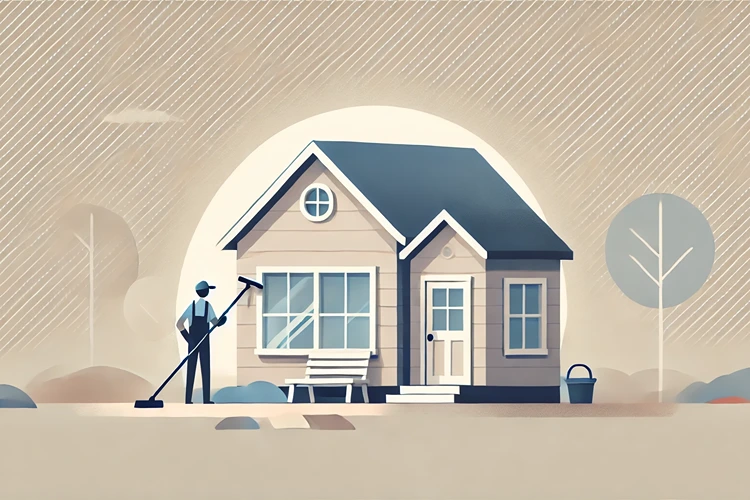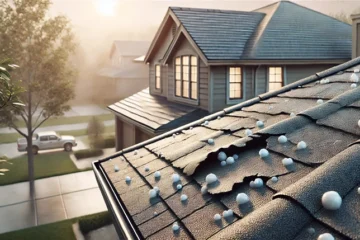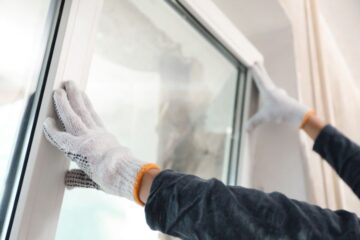Simple Maintenance Guide for Long-Lasting Vinyl Siding

Vinyl siding is a popular choice for homeowners due to its durability, versatility, and low maintenance requirements. However, to keep it looking its best and ensure it lasts for years, some regular upkeep is necessary. In this guide, we’ll explore a simple yet effective maintenance routine that will help you maintain the beauty and integrity of your vinyl siding. Whether you’re dealing with dirt, mold, or minor damages, this guide will cover everything you need to know to keep your vinyl siding in top condition.
Why is Vinyl Siding Maintenance Important?
Maintaining your vinyl siding is essential for several reasons. Over time, dirt, grime, and mildew can accumulate on the surface, leading to unsightly stains. Additionally, exposure to the elements can cause the color to fade, and minor damages left unchecked can develop into more significant issues. Regular maintenance not only preserves the aesthetic appeal of your home but also extends the lifespan of your siding, saving you money on repairs or replacements.
Helpful Hint:
Regular cleaning can prevent the buildup of grime and mildew on your vinyl siding, which helps in maintaining its original color and appearance. Aim to clean your siding at least once a year or more frequently if your home is located in a humid or dusty environment.
How Often Should You Clean Vinyl Siding?
One of the most common questions homeowners ask is how often they should clean their vinyl siding. The answer depends on several factors, including your local climate, the amount of dust and debris in your area, and the proximity of your home to trees or other vegetation. As a general rule of thumb, cleaning your siding once a year is sufficient for most homes. However, if you live in an area with high humidity or near the coast, where salt can accumulate, more frequent cleaning might be necessary.
Signs That Your Siding Needs Cleaning
- Visible dirt or grime buildup
- Mold or mildew spots
- Fading color
- Stains from tree sap or other organic materials
Best Practices for Cleaning Vinyl Siding
Cleaning vinyl siding is a straightforward process, but it’s important to do it correctly to avoid damaging the material. Here are the best practices for cleaning your siding:
Choosing the Right Cleaning Solution
When it comes to cleaning vinyl siding, not all solutions are created equal. Avoid harsh chemicals that can strip the color or damage the siding. Instead, opt for a mild detergent mixed with water. A solution of 70% water and 30% white vinegar is also effective for removing mold and mildew. For tougher stains, consider using a specialized vinyl siding cleaner available at most home improvement stores.
Tools You Will Need
To clean your vinyl siding effectively, you’ll need a few basic tools:
- A soft-bristle brush or sponge
- A garden hose with a spray nozzle
- A bucket
- Mild detergent or a vinegar-water solution
Step-by-Step Cleaning Process
Here’s a simple step-by-step guide to cleaning your vinyl siding:
- Start by rinsing the siding with water using a garden hose to remove loose dirt and debris.
- Mix your chosen cleaning solution in a bucket according to the manufacturer’s instructions.
- Dip a soft-bristle brush or sponge into the solution and gently scrub the siding, working from the bottom to the top.
- Pay special attention to areas with mold, mildew, or heavy staining. Use a little extra elbow grease to clean these spots thoroughly.
- Rinse the siding with clean water from the top down to remove any remaining soap or cleaner.
Preventing Mold and Mildew on Vinyl Siding
Mold and mildew are common issues for vinyl siding, especially in humid climates. These fungi can cause unsightly stains and may even lead to health problems if left untreated. Here are some tips to prevent mold and mildew from taking hold on your siding:
Maintain Proper Ventilation
Ensure that your home is well-ventilated, particularly in areas prone to moisture buildup like bathrooms and kitchens. Proper ventilation reduces humidity levels, making it harder for mold and mildew to thrive.
Keep Gutters and Downspouts Clean
Clogged gutters and downspouts can cause water to overflow and run down the side of your home, creating the perfect environment for mold and mildew growth. Regularly clean your gutters and ensure that downspouts direct water away from your home’s foundation.
Helpful Hint:
Trim back trees and shrubs that are close to your home. Plants that are too close to your siding can trap moisture and block sunlight, which can lead to mold and mildew growth. Keeping vegetation at least 2 feet away from your siding will help maintain airflow and reduce moisture buildup.
Repairing Minor Damages to Vinyl Siding
Even with regular maintenance, vinyl siding can sometimes suffer from minor damages like cracks, chips, or holes. Addressing these issues promptly will prevent them from worsening and extend the life of your siding.
How to Identify Damage
Inspect your siding regularly for any signs of damage. Look for cracks, warping, or loose panels. Pay attention to areas around windows, doors, and corners where damage is more likely to occur.
DIY Repairs vs. Professional Help
Minor damages such as small cracks or holes can often be repaired with a DIY approach. However, if you notice significant damage or if the siding is warped or buckling, it’s best to consult a professional. Attempting to repair extensive damage on your own could lead to more problems down the line.
Steps for DIY Repairs
If you’re comfortable with DIY repairs, here’s how to fix small cracks or holes in your vinyl siding:
- Clean the damaged area with a mild detergent and water.
- Dry the area thoroughly before beginning the repair.
- Use a vinyl siding repair kit, available at most home improvement stores, to fill the crack or hole.
- Smooth the repair compound with a putty knife and allow it to dry according to the manufacturer’s instructions.
- Once dry, paint over the repair with matching vinyl siding paint if necessary.
Stats:
According to a report by the Vinyl Siding Institute, properly maintained vinyl siding can last up to 60 years, making it a cost-effective choice for homeowners. Regular maintenance, including cleaning and timely repairs, can significantly extend the life of your siding.
Protecting Vinyl Siding from Extreme Weather
Vinyl siding is designed to withstand a variety of weather conditions, but extreme weather events like heavy storms, high winds, and hail can still cause damage. Taking proactive steps to protect your siding can minimize the risk and ensure it remains in good condition.
How to Protect Your Siding from Wind and Storm Damage
High winds and storms can cause vinyl siding to loosen, crack, or even break away from your home. Here are some steps you can take to protect your siding from wind and storm damage:
- Secure loose panels: Regularly inspect your siding and secure any loose panels with nails or screws. Loose panels are more likely to be damaged during a storm.
- Install storm shutters: Storm shutters can help protect your windows and siding from flying debris during a storm.
- Prune trees and shrubs: Trim back any branches that could break off and strike your siding during high winds.
- Anchor outdoor furniture: Secure any outdoor furniture or decorations that could become airborne and damage your siding in a storm.
Dealing with Hail Damage
Hail can be particularly damaging to vinyl siding, causing dents, cracks, or holes. If your home is in an area prone to hailstorms, it’s important to know how to address potential damage:
- Inspect your siding after a hailstorm for any visible damage. Look for dents, cracks, or holes that could compromise the siding’s integrity.
- For minor hail damage, such as small dents, you may be able to repair the area using a vinyl siding repair kit. For more extensive damage, consider replacing the affected panels.
- If the damage is significant, contact your insurance company to discuss coverage for repairs or replacement.
Seasonal Maintenance Tips for Vinyl Siding
Maintaining your vinyl siding throughout the year involves a few seasonal tasks that can help keep it in optimal condition. Here’s a breakdown of what you should do during each season:
Spring: Thorough Cleaning
Spring is the perfect time to give your siding a deep clean after the winter months. As mentioned earlier, use a mild detergent or vinegar-water solution to remove any dirt, grime, or mildew that has accumulated. Pay extra attention to the north side of your home, as it tends to receive less sunlight and may have more mold or mildew buildup.
Summer: Inspect and Repair
Summer is a good time to inspect your siding for any damage caused by spring storms or general wear and tear. Take note of any areas that need repair and address them before the fall and winter seasons. This is also a great time to check the caulking around windows and doors to ensure there are no gaps where water could seep in.
Helpful Hint:
During the summer, take advantage of the longer daylight hours to inspect your entire home’s exterior. Look for any signs of warping, fading, or damage that may need to be addressed. Keeping up with repairs during the warm months will help prevent more significant issues when the weather turns colder.
Fall: Gutter Maintenance
In the fall, make sure your gutters are clear of leaves and debris. Clogged gutters can lead to water overflow, which can damage your siding and even cause structural issues. Consider installing gutter guards to minimize the need for frequent cleaning.
Winter: Snow and Ice Management
In winter, snow and ice can cause problems for your siding, particularly if they accumulate against your home. Here’s what you can do:
- Remove snow from the base of your home to prevent it from piling up against your siding, which could lead to moisture damage.
- Be cautious when shoveling snow or using snow removal tools near your siding to avoid accidental damage.
- Keep an eye out for ice dams on your roof, as they can cause water to back up under your siding and into your home. Address ice dams promptly by removing snow from your roof or using heat cables to prevent ice buildup.
How to Maintain the Color of Vinyl Siding
One of the appealing features of vinyl siding is that it comes in a variety of colors that can enhance your home’s curb appeal. However, exposure to the sun’s UV rays can cause the color to fade over time. Here are some tips to help maintain the vibrant color of your vinyl siding:
Protecting Your Siding from UV Damage
UV rays from the sun are the primary cause of color fading in vinyl siding. While most modern vinyl siding is manufactured with UV inhibitors to resist fading, there are additional steps you can take:
- Choose lighter colors: If you’re installing new siding, consider opting for lighter colors. Lighter shades tend to fade less noticeably than darker ones.
- Use awnings or shade structures: Installing awnings or shade structures can protect your siding from direct sunlight, particularly on south-facing walls that receive the most sun exposure.
- Apply UV protectant: Some products are designed to add an extra layer of UV protection to your siding. These can be applied after cleaning your siding to help preserve its color.
Cleaning to Prevent Stains
Regular cleaning not only removes dirt and grime but also prevents stains that can mar the appearance of your siding. Here’s how to prevent and address common staining issues:
- For rust stains, which can occur if water from metal fixtures drips onto your siding, use a rust remover formulated for use on vinyl.
- If you notice stains from tree sap or bird droppings, clean them as soon as possible. These substances can become harder to remove the longer they sit.
- For stubborn stains, a solution of bleach and water (one part bleach to four parts water) can be used, but be sure to rinse thoroughly afterward to avoid any residue.
Stats:
A study by the National Association of Home Builders (NAHB) found that the most common cause of vinyl siding replacement is color fading, accounting for nearly 30% of cases. Regular maintenance and UV protection can significantly reduce the rate of fading and extend the life of your siding.
When Should You Consider Replacing Vinyl Siding?
Despite regular maintenance, there may come a time when your vinyl siding needs to be replaced. Knowing when to replace it can save you from more extensive damage and costly repairs down the line. Here are some signs that it might be time to consider a replacement:
Signs Your Siding Needs Replacement
While minor repairs can extend the life of your siding, there are certain signs that indicate it’s time for a complete replacement:
- Widespread fading or discoloration: If your siding has significantly faded or changed color over large areas, it may be time for a replacement.
- Multiple cracks or holes: Small cracks and holes can be repaired, but if you notice multiple areas with damage, it may be more cost-effective to replace the siding entirely.
- Warping or buckling: Siding that is warped or buckling indicates underlying issues, such as moisture damage or poor installation, which may require replacement.
- High energy bills: If your energy bills have increased, it could be a sign that your siding is no longer providing adequate insulation, and a replacement may be necessary.
Choosing the Right Time for Replacement
If you’ve decided it’s time to replace your vinyl siding, consider scheduling the replacement during the spring or summer months. This will ensure the installation process goes smoothly and avoid complications caused by cold or wet weather. Additionally, replacing your siding during these seasons allows you to address any insulation issues before the next winter.
Common Vinyl Siding Issues and Solutions
| Issue | Cause | Solution |
|---|---|---|
| Fading | UV Exposure | Apply UV protectant, repaint with compatible paint |
| Warping | Excessive heat, poor installation | Relocate heat sources, consult a professional for reinstallation |
| Mold and Mildew | High humidity, poor ventilation | Improve ventilation, clean regularly with a mild solution |
| Cracking | Cold weather impact | Avoid impacts during freezing temperatures, repair cracks promptly |
| Hail Damage | Severe weather | Inspect after storms, repair or replace damaged panels |
FAQs
Wrapping Up
Maintaining your vinyl siding is crucial for keeping your home looking great and ensuring its longevity. With regular cleaning, timely repairs, and protection against the elements, you can extend the life of your siding for decades. This Simple Maintenance Guide for Long-Lasting Vinyl Siding offers you practical steps to keep your home’s exterior in top shape, saving you money and enhancing your curb appeal. Remember, consistent care is the key to preserving the beauty and durability of your siding. Stay proactive, and your vinyl siding will continue to protect and beautify your home for years to come.


